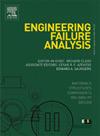连续碳/凯夫拉纤维和短碳纤维 3D 打印混合纤维复合材料的湿热老化和耐久性预测
IF 4.4
2区 工程技术
Q1 ENGINEERING, MECHANICAL
引用次数: 0
摘要
混合纤维增强聚合物(HFRP)具有优异的机械性能。然而,与传统方法相比,用三维打印技术制备的材料容易发生水热老化。目前,3D 打印 HFRP 复杂的水热老化和降解机制尚不清楚。因此,我们研究了连续碳/凯夫拉纤维和短碳纤维三维打印高频增强塑料的水热老化和耐久性预测,其中考虑了四种典型的堆叠序列。所有实验样品均采用熔融沉积成型(FDM)三维打印技术制造。对样品进行不同时间的人工加速老化试验,然后采用弯曲试验来评估其残余力学性能和失效模式。结果表明,堆积顺序对吸湿行为有显著影响,[OC4O2K4]S比[OK4O2C4]S吸湿更多。在老化过程中,三维打印高频增强塑料的抗弯性能先迅速下降,然后保持稳定。其中,[OK4O2C4]S 的降解速度最快,但具有最高的残余强度。OC8O4K8O 的降解速度最慢,但残余强度较低。分析了形态和微观失效模式/机制,以解释明显的机械降解。最后,采用阿伦尼乌斯关系准确预测和分析了试样的降解演变过程。这项研究为三维打印高频纤维增强塑料的湿热老化和耐久性提供了一个新的视角。本文章由计算机程序翻译,如有差异,请以英文原文为准。
Hygrothermal aging and durability prediction of 3D-printed hybrid fiber composites with continuous carbon/Kevlar-fiber and short carbon-fiber
Hybrid Fiber Reinforced Polymers (HFRP) have excellent mechanical properties. However, preparation with 3D-printing technology is prone to hydrothermal aging compared to conventional method. Currently, complex hygrothermal aging and degradation mechanisms of 3D-printed HFRP are still unclear. Thus, hygrothermal aging and durability prediction of 3D-printed HFRP with continuous carbon/Kevlar-fiber and short carbon-fiber are studied, which considers four typical stacking sequences. All experimental samples are manufactured by Fused Deposition Modeling (FDM) 3D-printing. The artificial accelerate aging testing is conducted on samples at different times, and then flexural testing is adopted to evaluate the residual mechanical properties and failure modes. The results show that the stacking sequence significantly influences the moisture absorption behaviors, and [OC4O2K4]S absorbed more moisture than [OK4O2C4]S. During the aging process, the flexural properties of the 3D-printed HFRP first decrease rapidly and then keep stable. Among them, [OK4O2C4]S have the fastest degradation but possessed the highest residual strength. OC8O4K8O possess the slowest degradation but have a lower residual strength. The morphologies and micro failure modes/mechanisms are analyzed to explain the significant mechanical degradation. Finally, the Arrhenius relationship is adopted to accurately predict and analyze the degradation evolution process of specimens. This work offers a novel perspective on the hygrothermal aging and durability of 3D-printed HFRP.
求助全文
通过发布文献求助,成功后即可免费获取论文全文。
去求助
来源期刊

Engineering Failure Analysis
工程技术-材料科学:表征与测试
CiteScore
7.70
自引率
20.00%
发文量
956
审稿时长
47 days
期刊介绍:
Engineering Failure Analysis publishes research papers describing the analysis of engineering failures and related studies.
Papers relating to the structure, properties and behaviour of engineering materials are encouraged, particularly those which also involve the detailed application of materials parameters to problems in engineering structures, components and design. In addition to the area of materials engineering, the interacting fields of mechanical, manufacturing, aeronautical, civil, chemical, corrosion and design engineering are considered relevant. Activity should be directed at analysing engineering failures and carrying out research to help reduce the incidences of failures and to extend the operating horizons of engineering materials.
Emphasis is placed on the mechanical properties of materials and their behaviour when influenced by structure, process and environment. Metallic, polymeric, ceramic and natural materials are all included and the application of these materials to real engineering situations should be emphasised. The use of a case-study based approach is also encouraged.
Engineering Failure Analysis provides essential reference material and critical feedback into the design process thereby contributing to the prevention of engineering failures in the future. All submissions will be subject to peer review from leading experts in the field.
 求助内容:
求助内容: 应助结果提醒方式:
应助结果提醒方式:


